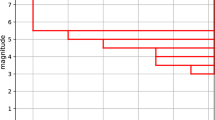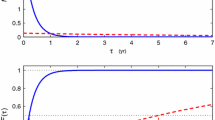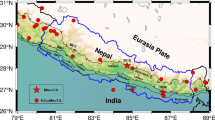Abstract
We propose a stochastic methodology for risk assessment of a large earthquake when a long time has elapsed from the last large seismic event. We state an approximate probability distribution for the occurrence time of the next large earthquake, by knowing that the last large seismic event occurred a long time ago. We prove that, under reasonable conditions, such a distribution is exponential with a rate depending on the asymptotic slope of the cumulative intensity function corresponding to a nonhomogeneous Poisson process. As it is not possible to obtain an empirical cumulative distribution function of the waiting time for the next large earthquake, an estimator of its cumulative distribution function based on existing data is derived. We conduct a simulation study for detecting scenario in which the proposed methodology would perform well. Finally, a real-world data analysis is carried out to illustrate its potential applications, including a homogeneity test for the times between earthquakes.

Similar content being viewed by others
References
Adelfio G, Chiodi M (2015) Alternated estimation in semi-parametric space-time branching-type point processes with application to seismic catalogs. Stoch Environ Res Risk Assess 29:443–450
Arkin B, Leemis L (2000) Nonparametric estimation of the cumulative intensity function for a non-homogeneous Poisson process from overlapping realizations. Manag Sci 46:989–998
Balakrishnan N, Stehlík M (2015) Likelihood testing with censored and missing duration data. J Stat Theory Pract 9:2–22
Breiman L (1968) Probability. Addison-Wesley, Menlo Park
Brémaud P (1981) Point processes and queues. Martingale dynamics. Springer, New York
Cornell C (1968) Engineering seismic risk analysis. Bull Seismol Soc Am 58:1583–1606
Dacunha-Castelle D, Duflo M (1986) Probability and statistics, vol 2. Springer, New York
Dargahi-Noubary G (1986) A method for predicting future large erthquakes using extreme order statistics. Phys Earth Planet Inter 42:241–245
Dieterich J (1988) Probability of earthquake recurrence with non-uniform stress rates and time-dependent failure. Pure Appl Geophys 126:589–617
Fierro R (2015) Functional limit theorems for the multivariate Hawkes process with different exciting functions. Latin Am J Probab Math Stat 12:477–489
Fierro R, Leiva V, Møller J (2015) The Hawkes process with different exciting functions and its asymptotic behavior. J Appl Probab 52:37–54
Fierro R, Leiva V, Ruggeri F, Sanhueza A (2013) On the Birnbaum-Sauders distribution arising from a non-homogeneous Poisson process. Stat Probab Lett 83:1233–1239
Fukutan Y, Suppasri A, Imamura F (2015) Stochastic analysis and uncertainty assessment of tsunami wave height using a random source parameter model that targets a tohoku-type earthquake fault. Stoch Environ Res Risk Assess 29:1763–1779
Gutenberg R, Richter C (1944) Frequency of earthquakes in California. Bull Seismol Soc Am 34:185–188
Henderson S (2003) Estimation for non-homogeneous Poisson processes from aggregated data. Oper Res Lett 31:375–382
Hristopulos D, Mouslopoulou V (2013) Strength statistics and the distribution of earthquake inter-event times. Physica A 392:485–496
Kagan Y (1997) Are eathquakes predictable? Geophys J Int 131:505–525
Kamat R (2015) Planning and managing earthquake and flood prone towns. Stoch Environ Res Risk Assess 29:527–545
Karr A (1991) Point processes and their statistical inference. Marcel Dekker, New York
Kim D, Kim B, Lee S, Cho Y (2014) Best-fit distribution and log-normality for tsunami heights along coastal lines. Stoch Environ Res Risk Assess 28:881–893
Knopoff L, Kagan Y (1977) Analysis of the theory of extremes as applied to earthquake problems. J Geophys Res 82:5647–5657
Leemis L (1991) Nonparametric estimation of the cumulative intensity function for a non-homogeneous Poisson process. Manag Sci 37:886–900
Leemis L (2004) Nonparametric estimation and variate generation for a non-homogeneous Poisson process from event count data. IIE Trans 36:1155–1160
Lewis P, Shedler G (1979) Simulation of non-homogeneous Poisson process by thinning. Nav Res Logist 26:403–413
Nicolis O, Chiodi M, Adelfio G (2015) Windowed ETAS models with application to the Chilean seismic catalogs. Spat Stat 14:151–165
Nishenko S, Buland R (1987) A generic recurrence interval distribution for earthquake forecasting. Bull Seismol Soc Am 77:1382–1399
Ogata Y (1988) Statistical models for earthquake occurrences and residual analysis for point processes. J Am Stat Assoc 83:9–27
Omori F (1895) On the after-schoks of earthquakes. J Coll Sci Imp Univ 7:111–200
Panthi A, Shander D, Singh H, Kumar A, Paudyal H (2011) Time-predictable model applicability for earthquake occurrence in northeast India and vicinity. Nat Hazards Earth Syst Sci 39:993–1002
Reid H (1910) The mechanics of the earthquake, the California earthquake of April 18-1906. Technical report 2. Carnegie Institution of Washington, Washington
Rikitake T (1976) Recurrence of great earthquakes at subduction zones. Tectonophysics 35:335–362
Roussas G (1997) A course in mathematical statistics. Academic Press, Burlington
Rubinstein J, Ellsworth W, Beeler N, Kilgore B, Lockner D, Savage H (2012) Fixed recurrence and slip models better predict earthquake behavior than the time- and slip-predictable models 2: Laboratory earthquakes. J Geophys Res 117:B02307
Shimazaki K, Nakata T (1980) Time-predictable recurrence model for large earthquakes. Geophys Res Lett 7:279–282
Sturges H (1926) The choice of a class interval. J Am Stat Assoc 21:65–66
Tucker HG (1967) A graduate course in probability. Academic Press, New York
Wesnousky S, Scholz C, Shimazaki K, Matsuda T (1984) Integration of geological and seismological data for mthe analysis of seismic hazard: a case of study in Japan. Bull Seismol Soc Am 74:687–708
Yakovlev G, Turcotte D, Rundle J, Rundle P (2007) Simulation-based distributions of earthquake recurrence times on the San Andreas fault system. Bull Seismol Soc Am 96:1995–2007
Acknowledgments
The authors thank the editors and referees for their constructive comments on an earlier version of this manuscript which resulted in this improved version. This research was partially supported by FONDECYT 1160868 Grant of CONICYT-Chile.
Author information
Authors and Affiliations
Corresponding author
Appendix
Appendix
Proof of Proposition 2.1
Let L and \(L^\lambda\) be an HPP and an NHPP, respectively, where L has rate equal to one and \(L^\lambda\) has intensity \(\lambda\). Let \(\tau _k\) and \(\tau _k^\lambda\) be the kth jump of L and \(L^\lambda\), respectively. Consequently, \(T_k\) and \(\tau _k^\lambda\) are equal in distribution and since \(L^\lambda _t\) has the same distribution that \(L_{\Lambda (t)}\), we have
Therefore, the PDF of \(T_k\) is given by (2.4). \(\square\)
Proof of Theorem 3.1
Let F be the CDF of T. Then, by the L’Hôpital rule and the fundamental theorem of calculus, we have
Consequently,
Thus, by taking limit as \(\Delta h \rightarrow 0\) in (8.1), we have that \({{\text{d}}}G(h)/{\text{d}}h = G'(h)=G'(0)(1-G(h))\). This differential equation has a unique solution, for \(G'(0)=m\), which is given by \(G(h)=1-\exp (-m h)\). Therefore, the proof is complete. \(\square\)
Proof of Theorem 3.2
From the L’Hôpital rule, we have
In addition, from the mean value theorem, there exists \(\xi (t)\) between t and \(t+h\), with \(t >0\) and \(h\ge 0\), such that \(\Lambda (t+h)-\Lambda (t)=\lambda (\xi (t))h\). Consequently,
Thus, because
the proof follows from (i) in Theorem 3.1. \(\square\)
Proof of Theorem 4.1
For each \(\varepsilon >0\), let \(t_0>0\), such that \(|\lambda (s)-m|<\varepsilon\), whenever \(s\ge t_0\). Consequently, for each \(t>t_0\), we have
By taking limit as \(t\rightarrow \infty\), we obtain
As \(\varepsilon >0\) is arbitrary, we have \(\lim _{t\rightarrow \infty }{\Lambda (t)}/{t} = m\), which concludes the proof. \(\square\)
Proof of Theorem 4.2
Let \(M=\{M_t;t\ge 0\}\) be the martingale defined by \(M_t=N_t-\Lambda (t)\). As
and Theorem 8.2.17 in Dacunha-Castelle and Duflo (1986) implies \(\lim _{t\rightarrow \infty }(M_t-M_{\tau ^*})/(\Lambda (t)-\Lambda (\tau ^*))=0\), \({\mathbb{P}}\)-a.s., from Theorem 4.1, we have \(\lim _{n\rightarrow \infty }{(N_t-N_{\tau ^*})}/{(t-\tau ^*)}=m\), \({\mathbb{P}}\)-a.s.
Suppose that \(\lim _{t\rightarrow \infty }\sqrt{t}({\Lambda (t)}/{t}-m)=0\) and let L be an HPP with rate equal to one. For each \(t\ge \tau ^*\), we have
Consequently, to prove that
and since \(\lim _{t\rightarrow \infty } L_{\Lambda (\tau ^*)}/\sqrt{t-\tau ^*}=0\), we need to prove
As \((L_t-t)/\sqrt{t}\mathop {\rightarrow } \limits ^{\mathcal {D}} {\rm N}(0,1)\) and \(\lim _{t\rightarrow \infty }\Lambda (t)/(t-\tau ^*)=m\), condition (8.3) follows. From the intermediate value theorem, for each \(t>0\), there exists \(\xi (t)\) between \(t-\tau ^*\) and t such that \(\Lambda (t) = \Lambda (t-\tau ^*)+\lambda (\xi (t))\tau ^*\). This fact implies that
Because \(\lim _{t\rightarrow \infty }\sqrt{t-\tau ^*}({\Lambda (t-\tau ^*)}/{(t-\tau ^*)}-m)=0\) is assumed and \(\lambda\) is bounded, condition (8.4) holds. Hence, we have proven condition (8.2), but due to \(N_t-N_{\tau ^*}\) and \(L_{\Lambda (t)}-L_{\Lambda (\tau ^*)}\) have the same distribution, for each \(t>0\), we have
which completes the proof. \(\square\)
Proof of Theorem 5.1
From (i) in Theorem 4.2, for each \(h>0,\) \(\widehat{G}_\tau (h)\mathrel {\mathop {\longrightarrow }\limits ^{}_{n\rightarrow \infty }} G(h),\) \({\mathbb{P}}\)-a.s. Hence, it follows from the Pólya Lemma (Roussas, 1997) that, as \(\tau \rightarrow \infty\), \(\{\widehat{G}_\tau ; \tau >0\}\) converges, \({\mathbb{P}}\)-a.s., uniformly to the CDF G, which concludes the proof. \(\square\)
Proof of Theorem 5.2
From the intermediate value theorem, there exists \(\xi _\tau\) between \(\widehat{m}_\tau\) and m such that \(\widehat{G}_\tau (h)-G(h)=h\exp (-\xi _\tau h)(m-\widehat{m}_\tau )\). Then,
However, from (i) and (ii) of Theorem 4.2, \(\lim _{\tau \rightarrow \infty }\xi _\tau =m\), \({\mathbb{P}}\)-a.s., and \(\sqrt{\tau }(\widehat{m}_\tau -m)\mathop {\rightarrow }\limits ^{\mathcal {D}}\,{\rm N}(0,m)\), respectively. Therefore, the proof follows from the Slutsky theorem. \(\square\)
Rights and permissions
About this article
Cite this article
Fierro, R., Leiva, V. A stochastic methodology for risk assessment of a large earthquake when a long time has elapsed. Stoch Environ Res Risk Assess 31, 2327–2336 (2017). https://doi.org/10.1007/s00477-016-1288-5
Published:
Issue Date:
DOI: https://doi.org/10.1007/s00477-016-1288-5




